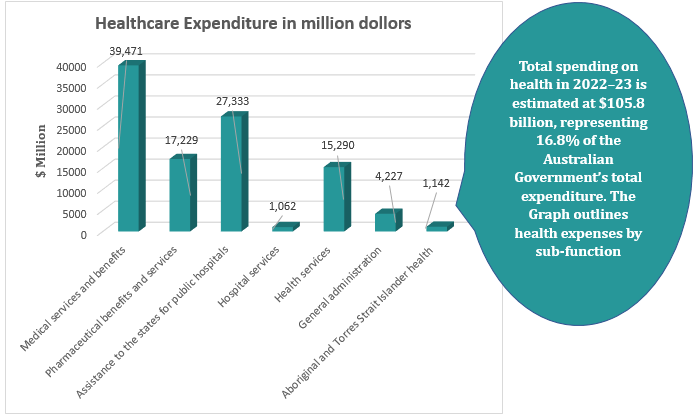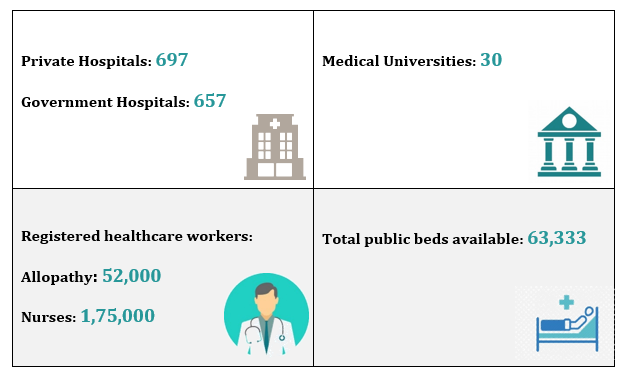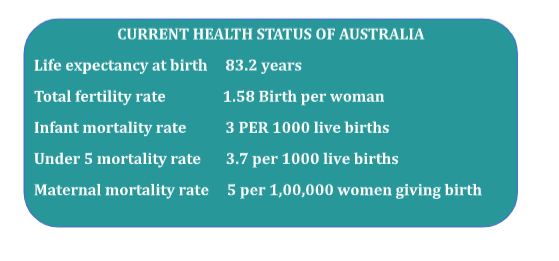Are you currently looking into venturing or investing in the healthcare sector of Australia? Are you looking for concrete details on the current status of the Healthcare scenario in Australia? In this article, Hospacxx Healthcare Consultancy brings to you the latest bits of Information on Australia’s current Healthcare Systems and their upcoming new sectors.
INTRODUCTION
Australia’s healthcare system is widely regarded as one of the best in the world, offering comprehensive and accessible healthcare services to its population. With a strong emphasis on universal healthcare, Australia prioritizes the well-being of its citizens and ensures that quality medical care is available to all, regardless of their socio-economic background.
The healthcare sector in Australia is characterized by a robust infrastructure, highly skilled healthcare professionals, advanced technology, and a focus on preventive care and health promotion. An efficient and patient-centric healthcare scenario exists in Australia, contributing to the overall health and well-being of its population.
HEALTHCARE INDUSTRY MARKET SCENARIO OF AUSTRALIA
The healthcare market in Australia is a dynamic and thriving sector that plays a crucial role in the country’s overall well-being. Australia’s healthcare industry is distinguished by a blend of public and private providers collaborating to provide complete medical services to its population, with a heavy emphasis on public healthcare. Healthcare revenue is expected to show an annual growth rate (CAGR 2023-2027) of 8.48%, resulting in a projected market volume of US$1,572.00m by 2027.
HEALTHCARE EXPENDITURE IN AUSTRALIA

HEALTH INSURANCE IN AUSTRALIA
Australia has a robust healthcare system that includes both public and private health
insurance schemes. The public healthcare system is known as Medicare, while the
private health insurance schemes are offered by various insurance companies. Some of
the key health insurance schemes in Australia:
|
1. Medicare: Medicare is Australia’s public healthcare system, which provides access to a range of essential medical services. Under Medicare, Australian citizens and permanent residents are entitled to free or subsidized treatment by doctors, specialists, and public hospitals. Medicare covers a portion of the costs for medical services and pharmaceuticals. 2. Pharmaceutical Benefits Scheme (PBS): The PBS is part of Medicare and provides subsidized access to a wide range of prescription medications. Under the PBS, patients pay a co-payment amount for each prescribed medication, with the government covering the remaining cost. This ensures affordable access to essential medicines. 3. Private Health Insurance: Private health insurance in Australia is optional, but many Australians choose to have it to access additional healthcare services and avoid waiting lists for elective procedures. Private health insurance covers services not covered by Medicare, such as private hospital accommodation, dental care, optical services, and some alternative therapies. 4. Lifetime Health Cover (LHC): LHC is a financial loading that encourages Australians to take out private hospital cover earlier in life and maintain it. If individuals delay taking out private hospital cover beyond their 31st birthday, they may have to pay an additional 2% loading on their premium for every year they are aged over 30 when they first take out private health insurance. 5. Medicare Levy Surcharge (MLS): The MLS is an additional tax imposed on high-income earners who do not have private hospital cover. It encourages individuals to take out private hospital cover and reduce the strain on the public health system. |
HEALTHCARE SECTOR COMPOSITION

CHRONIC DISEASES IN AUSTRALIA
NAB research suggests that around 4 in 10 Australians require ongoing treatment or medication for a medical condition, with over 8 in 10 of these “chronic” (i.e. lasting or expected to last 6 months or more). The most common conditions are mental & behavioral (anxiety, depression, etc.), impacting around 1 in 4 people. Just under 1 in 4 are afflicted by back problems & 1 in 5 have arthritis and diabetes. A significant number also suffer from heart, stroke & vascular disease, asthma, and osteoporosis. With the exception of mental health, these conditions disproportionately affect older people.
AUSTRALIA’S KEY HEALTH INDICATORS

HEALTHCARE CHALLENGES IN AUSTRALIA
Rising healthcare costs:
- Rising healthcare costs pose a significant challenge within the Australian healthcare market. Out-of-pocket medical costs are hitting Australian households, with more than 1 million people forking out $1000 a year on out-of-hospital services and medications, while those unable to afford it miss out on care.
- A Grattan Institute analysis found the biggest spenders – about 25,000 people – paid an average $3000 a year on health expenses, with fees charged by specialists such as dermatologists, obstetricians, and cardiologists a major contributor after the average gap increased by 50 percent in a decade.
- The increasing costs of medical treatments, technologies, and pharmaceuticals put pressure on both the public and private healthcare sectors.
- This can result in reduced affordability and accessibility of healthcare services for some individuals and families.
- To address this challenge, healthcare reforms are being implemented to improve cost-effectiveness, efficiency, and transparency within the healthcare system.
Aging population in Australia:
- The proportion of elderly citizens is steadily increasing, leading to greater demand for healthcare services, particularly in areas such as aged care, chronic disease management, and palliative care.
- The percentage of the Australian population aged 65 and over has increased, from 4.6% in 1922 to 2% in 2021.
- The percentage of older Australians in the population is set to continue increasing to approximately 20.7% in 2066, with particular growth between 2009 and 2029.
- This places strain on the healthcare system and requires adjustments to address the specific healthcare needs of older adults.
- Efforts are being made to enhance geriatric care, promote healthy aging, and develop age-friendly healthcare services and facilities to cater to the unique needs of the aging population.
Health disparities among Indigenous Australians and rural communities:
- Addressing health disparities among Indigenous Australians and rural communities is a critical challenge in the Australian healthcare market.
- Indigenous Australians often experience poorer health outcomes compared to the non-Indigenous population, with higher rates of chronic diseases, lower life expectancy, and limited access to healthcare services.
- Similarly, rural and remote communities face geographical barriers that limit their access to healthcare facilities and specialists.
- Efforts are being made to address these disparities through targeted healthcare programs and initiatives.
LIST OF MAJOR HOSPITALS IN AUSTRALIA
- Royal Prince Alfred Hospital (Sydney, New South Wales)- RPA was established in 1882 and has approximately 900 beds. It is a premier tertiary and quaternary referral hospital, recognized as a leader in healthcare excellence and innovation. A key hospital of Sydney Local Health District, RPA serves its local community and patients from across NSW, Australia, and internationally.
- Royal Melbourne Hospital (Melbourne, Victoria)-Royal Melbourne Hospital (RMH) began in 1848 as Victoria’s first public hospital with only 10 beds. Today, the RMH is one of the largest health providers in Australia, providing a comprehensive range of specialist medical, surgical and mental health services, as well as rehabilitation, aged care, specialist clinics and community programs. Currently it has approximately 1400 beds.
- Princess Alexandra Hospital (Brisbane, Queensland)- Princess Alexandra Hospital is a tertiary health care centre, provides care in most major adult specialties. It was established in 1956 and has approximately 900 beds. It is nationally recognized for its expertise in trauma management and organ transplants.
- Sir Charles Gairdner Hospital (Perth, Western Australia)- Sir Charles Gairdner Hospital (SCGH) is one of Australia’s leading teaching tertiary hospitals. I was established in 1958. It has more than 600 beds and employs about 5,500 staff who treat more than 4,20,000 patients each year.
- The Alfred Hospital (Melbourne, Victoria)- The Alfred Hospital, also known as The Alfred or Alfred Hospital, is a leading tertiaryteaching hospital in Melbourne, Victoria. It was established in 1871 and has approximately 600 beds. It is the second oldest hospital in Victoria, and the oldest Melbourne hospital still operating on its original site.
- Royal Adelaide Hospital (Adelaide, South Australia)- The Royal Adelaide Hospital (RAH)is South Australia’s largest public acute care teaching hospital with a 24-hour Emergency Department (ED), outpatient services, and more. It was established in 1840 and has approximately 800 beds.
- Westmead Hospital (Sydney, New South Wales)- Westmead Hospital is a member of the Westmead Health and Education Super Precinct, with close relationships to The Children’s Hospital at Westmead, the University of Sydney, the Westmead Institute for Medical Research, and the Children’s Medical Research Institute. It was established in 1978 and has approximately 900 beds.
- Royal Brisbane and Women’s Hospital (Brisbane, Queensland)- RBWH is Queensland’s largest hospital and provides a wide range of clinical services in the heart of Brisbane. RBWH employs more than 9,000 multidisciplinary staff that together provide more than one million episodes of life-saving treatment each year. It was established in 1867 and has approximately 1,000 beds.
- Fiona Stanley Hospital (Perth, Western Australia)- Fiona Stanley Hospital (FSH) was established in 2014 and has approximately 783 beds. It is a state government hospital and teaching facility in Murdoch, Western Australia.
- Austin Hospital (Melbourne, Victoria)- The Austin Hospital is a public teaching hospitalin Melbourne‘s north-eastern suburb of Heidelberg, and is administered by Austin Health, along with the Heidelberg Repatriation Hospitaland the Royal Talbot Rehabilitation Centre. It was established in 1882 and has approximately 470 beds.
CONCLUSION
Australia’s healthcare system is distinguished by a robust and comprehensive system that aims to offer its population affordable and high-quality healthcare services. Australia places a high focus on providing universal healthcare through programmes like Medicare, ensuring that everyone has access to necessary medical treatment regardless of their socioeconomic status.
A robust infrastructure, highly qualified medical staff, cutting-edge technology, and an emphasis on preventative care and health promotion underpin Australia’s healthcare system. The nation’s dedication to medical innovation and research also helps to progress healthcare and improve patient outcomes.
Australia is working to guarantee that all of its residents have equitable access to high-quality care that is also affordable. Australia’s healthcare system continues to be a pillar of the country’s dedication to the welfare and health of its citizens thanks to a patient-centric approach and continual advances.
Above is the superficial and macro level study for in-depth market and financial feasibility studies or any other healthcare-related research needs, please feel free to reach out to us at +91-8655170700 or email us at hospaccx.india@gmail.com . Our team is equipped to provide comprehensive and detailed insights tailored to your specific requirements.

